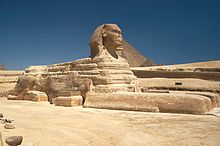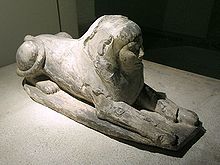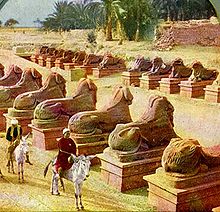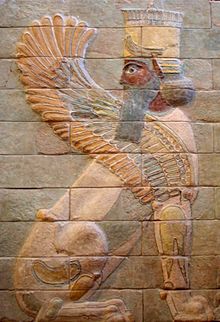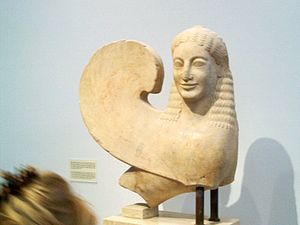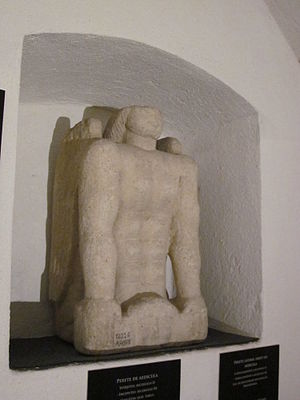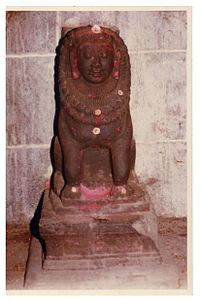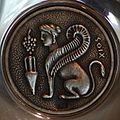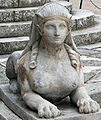- Sphinx
-
This article is about sphinxes in general. For the sphinx at Giza in Egypt, see Great Sphinx of Giza. For other uses, see Sphinx (disambiguation).
A sphinx (Greek: Σφίγξ /sphinx, Bœotian: Φίξ /Phix) is a mythical creature with a lion's body and a human head or a cat head.
The sphinx, in Greek tradition, has the haunches of a lion, the wings of a great bird, and the face of a woman. She is mythicised as treacherous and merciless. Those who cannot answer her riddle suffer a fate typical in such mythological stories, as they are killed and eaten by this ravenous monster.[1] Unlike the Greek sphinx which was a woman, the Egyptian sphinx is typically shown as a man (an androsphinx). In addition, the Egyptian sphinx was viewed as benevolent in contrast to the malevolent Greek version and was thought of as a guardian often flanking the entrances to temples.
In European decorative art, the sphinx enjoyed a major revival during the Renaissance. Later, the sphinx image, something very similar to the original Ancient Egyptian concept, was exported into many other cultures, albeit often interpreted quite differently due to translations of descriptions of the originals and the evolution of the concept in relation to other cultural traditions.
Generally the role of sphinxes is associated with architectural structures such as royal tombs or religious temples. The oldest known sphinx was found in Gobekli Tepe, Turkey and was dated to 9,500 BC.[2]
Contents
Egyptian sphinxes
The sphinx is located in the north and below the pyramids. What names their builders gave to these statues is not known. At the Great Sphinx site, the inscription on a stele erected a thousand years later, by Thutmose IV in 1400 BCE, lists the names of three aspects of the local sun deity of that period, Khepera - Rê - Atum. The inclusion of these figures in tomb and temple complexes quickly became traditional and many pharaohs had their heads carved atop the guardian statues for their tombs to show their close relationship with the powerful solar deity, Sekhmet, a lioness. Other famous Egyptian sphinxes include one bearing the head of the pharaoh Hatshepsut, with her likeness carved in granite, which is now in the Metropolitan Museum of Art in New York, and the alabaster sphinx of Memphis, Memphis, Egypt, currently located within the open-air museum at that site. The theme was expanded to form great avenues of guardian sphinxes lining the approaches to tombs and temples as well as serving as details atop the posts of flights of stairs to very grand complexes. Nine hundred with ram heads, representing Amon, were built in Thebes, where his cult was strongest.
Perhaps the first sphinx in Egypt was one depicting Queen Hetepheres II, of the fourth dynasty that lasted from 2723 to 2563 BC. She was one of the longest-lived members of the royal family of that dynasty.
The largest and most famous is the Great Sphinx of Giza, Arabic: أبو الهول, sited at the Giza Plateau on the west bank of the Nile River and facing due east (29°58′31″N 31°08′15″E / 29.97528°N 31.1375°E). It is also from the same dynasty. Although the date of its construction is uncertain, the head of the Great Sphinx now is believed to be that of the pharaoh Khafra.
Greek traditions
From the Bronze Age, the Hellenes had trade and cultural contacts with Egypt. Before the time that Alexander the Great occupied Egypt, the Greek name, sphinx, was already applied to these statues. The historians and geographers of Greece wrote extensively about Egyptian culture. Heredotus called the ram-headed sphinxes, criosphinges, and the hawk-headed ones, hieracosphinges.
The word sphinx comes from the Greek Σφίγξ, apparently from the verb σφίγγω (sphíngō), meaning "to squeeze", "to tighten up".[3][4] This name may be derived from the fact that the hunters for a pride of lions are the lionesses, and kill their prey by strangulation, biting the throat of prey and holding them down until they die. The word sphincter derives from the same root. However, the historian Susan Wise Bauer suggests that the word "sphinx" was instead, a Greek corruption of the Egyptian name "shesepankh," which meant "living image," and referred rather to the statue of the sphinx, which was carved out of "living rock" (rock that was present at the construction site, not harvested and brought from another location), than to the beast itself.[5]
There was a single sphinx in Greek mythology, a unique demon of destruction and bad luck. According to Hesiod, she was a daughter of Orthus[6] and either Echidna or the Chimera, or perhaps even Ceto;[7] according to others, she was a daughter of Echidna and Typhon. All of these are chthonic figures from the earliest of Greek myths, before the Olympians ruled the Greek pantheon. The Sphinx is called Phix (Φίξ) by Hesiod in line 326 of the Theogony, the proper name for the Sphinx noted by Pierre Grimal's The Penguin Dictionary of Classical Mythology.
In Greek mythology, a sphinx is represented as a monster with a head of a woman, the body of a lioness, the wings of an eagle, and a serpent headed tail.
The sphinx was the emblem of the ancient city-state of Chios, and appeared on seals and the obverse side of coins from the 6th century BC until the 3rd century AD.
Athena appears in the middle of the upper-half of the middle of a sarcophagus found in the middle pyramid of Giza, with two sphinxes at her side.
The Riddle of the Sphinx
The Sphinx is said to have guarded the entrance to the Greek city of Thebes, and to have asked a riddle of travellers to allow them passage. The exact riddle asked by the Sphinx was not specified by early tellers of the stories, and was not standardized as the one given below until late in Greek history.[8]
It was said in late lore that Hera or Ares sent the Sphinx from her Ethiopian homeland (the Greeks always remembered the foreign origin of the Sphinx) to Thebes in Greece where she asks all passersby the most famous riddle in history: "Which creature in the morning goes on four legs, at mid-day on two, and in the evening upon three, and the more legs it has, the weaker it be?" She strangled and devoured anyone unable to answer. Oedipus solved the riddle by answering: Man—who crawls on all fours as a baby, then walks on two feet as an adult, and then walks with a cane in old age. By some accounts[9] (but much more rarely), there was a second riddle: "There are two sisters: one gives birth to the other and she, in turn, gives birth to the first." The answer is "day and night" (both words are feminine in Greek).
Bested at last, the tale continues, the Sphinx then threw herself from her high rock and died. An alternative version tells that she devoured herself. Thus Oedipus can be recognized as a "liminal" or threshold figure, helping effect the transition between the old religious practices, represented by the death of the Sphinx, and the rise of the new, Olympian gods.
In Jean Cocteau's retelling of the Oedipus legend, The Infernal Machine, the Sphinx tells Oedipus the answer to the riddle, to kill herself so that she did not have to kill anymore, and also to make him love her. He leaves without ever thanking her for giving him the answer to the riddle. The scene ends when the Sphinx and Anubis, who is there to kill the victims who cannot answer the riddle, ascend back to the heavens.
Sphinxes in South and South-East Asia
A composite mythological being with the body of a lion and the head of a human being is present in the traditions, mythology and art of South and South-East Asia[10] Variously known as purushamriga (Sanskrit, "man-beast"), purushamirukam (Tamil, "man-beast"), naravirala (Sanskrit, "man-cat") in India, or as nara-simha (Sanskrit, "man-lion") in Sri Lanka, manusiha or manuthiha (Pali, "man-lion") in Myanmar, and nora nair or thepnorasingh in Thailand.
In contrast to the sphinx in Egypt, Mesopotamia, and Greece, where the traditions largely have been lost due to the discontinuity of the civilization,[11] the traditions of the "Asian sphinx" are very much alive today. The earliest artistic depictions of "sphinxes" from the South Asian subcontinent are to some extent influenced by Hellenistic art and writings. These hail from the period when Buddhist art underwent a phase of Hellenistic influence.
In South India, the "sphinx" is known as purushamriga (Sanskrit) or purushamirukam (Tamil), meaning "man-beast". It is found depicted in sculptural art in temples and palaces where it serves an apotropaic purpose, just as the "sphinxes" in other parts of the ancient world.[12] It is said by the tradition, to take away the sins of the devotees when they enter a temple and to ward off evil in general. It is therefore often found in a strategic position on the gopuram or temple gateway, or near the entrance of the Sanctum Sanctorum.
The purushamriga plays a significant role in daily as well as yearly ritual of South Indian Shaiva temples. In the sodasa-upacara (or sixteen honors) ritual, performed between one to six times at significant sacred moments through the day, it decorates one of the lamps of the diparadhana or lamp ceremony. And in several temples the purushamriga is also one of the vahana or vehicles of the deity during the processions of the Brahmotsava or festival.
In Kanya Kumari district, in the southernmost tip of the Indian subcontinent, during the night of Shiva Ratri, devotees run 75 kilometres while visiting and worshiping at twelve Shiva temples. This Shiva Ottam (or Run for Shiva) is performed in commemoration of the story of the race between the Sphinx and Bhima, one of the heroes of the epic Mahabharata.
The Indian conception of a sphinx that comes closest to the classic Greek idea, is in the concept of the Sharabha, a mythical creature, part lion, part man and part bird, and the form of Sharabha that god Shiva took on to counter Narasimha's violence.
In Philippines, the sphinx is known as nicolonia. It is depicted as part man and part eagle that is known to ask riddles to wanderers who trespass in the Bicol region. Anyone who fails to answer its riddle is said to be carried off to the Mayon Volcano where they are said to be offered to the volcano god, Gev'ra, to appease his anger.
In Sri Lanka, the sphinx is known as narasimha or man-lion. As a sphinx, it has the body of a lion and the head of a human being, and is not to be confused with Narasimha, the fourth reincarnation of the deity Vishnu; this avatar or incarnation is depicted with a human body and the head of a lion. The "sphinx" narasimha is part of the Buddhist tradition and functions as a guardian of the northern direction and also was depicted on banners.
In Burma, the sphinx is known as manussiha (manuthiha). It is depicted on the corners of Buddhist stupas, and its legends tell how it was created by Buddhist monks to protect a new-born royal baby from being devoured by ogresses.
Nora Nair and Thep Norasingh are two of the names under which the "sphinx" is known in Thailand. They are depicted as upright walking beings with the lower body of a lion or deer, and the upper body of a human. Often they are found as female-male pairs. Here, too, the sphinx serves a protective function. It also is enumerated among the mythological creatures that inhabit the ranges of the sacred mountain Himapan.[13]
Revived sphinxes in Europe
The revived Mannerist sphinx of the 16th century is sometimes thought of as the French sphinx. Her coiffed head is erect and she has the breasts of a young woman. Often she wears ear drops and pearls as ornaments. Her body is naturalistically rendered as a recumbent lioness. Such sphinxes were revived when the grottesche or "grotesque" decorations of the unearthed "Golden House" (Domus Aurea) of Nero were brought to light in late 15th century Rome, and she was incorporated into the classical vocabulary of arabesque designs that spread throughout Europe in engravings during the 16th and 17th centuries. Sphinxes were included in the decoration of the loggia of the Vatican Palace by the workshop of Raphael (1515–20), which updated the vocabulary of the Roman grottesche.
The first appearances of sphinxes in French art are in the School of Fontainebleau in the 1520s and 1530s and she continues into the Late Baroque style of the French Régence (1715–1723).
From France, she spread throughout Europe, becoming a regular feature of the outdoors decorative sculpture of 18th-century palace gardens, as in the Upper Belvedere Palace in Vienna, Sanssouci Park in Potsdam, La Granja in Spain, Branicki Palace in Białystok, or the late Rococo examples in the grounds of the Portuguese Queluz National Palace (of perhaps the 1760s), with ruffs and clothed chests ending with a little cape.
Sphinxes are a feature of the neoclassical interior decorations of Robert Adam and his followers, returning closer to the undressed style of the grottesche. They had an equal appeal to artists and designers of the romantic, and later symbolism movements in the 19th century. Most of these sphinxes alluded to the Greek sphinx, rather than the Egyptian, although they may not have wings.
Sphinxes in Freemasonry
The sphinx image also has been adopted into Masonic architecture. Among the Egyptians, sphinxes were placed at the entrance of the temple to guard the mysteries, by warning those who penetrated within, that they should conceal a knowledge of them from the uninitiated. Champollion says that the sphinx became successively the symbol of each of the gods, by which portal suggests that the priests intended to express the idea that all the gods were hidden from the people, and that the knowledge of them, guarded in the sanctuaries, was revealed to the initiates only. As a Masonic emblem, the sphinx has been adopted in its Egyptian character as a symbol of mystery, and as such often is found as a decoration sculptured in front of Masonic temples, or engraved at the head of Masonic documents. It cannot, however, be properly called an ancient, recognized symbol of the order. Its introduction has been of comparatively recent date, and rather as a symbolic decoration than as a symbol of any particular dogma.
Similar creatures
- The 32,000 year old Aurignacian Löwenfrau Goddess is the oldest known anthropomorphic statue. Previously known as the Lion man, she has a human female body and a lioness head.
- Not all human-headed animals of antiquity are sphinxes. In ancient Assyria, for example, bas-reliefs of shedu bulls with the crowned bearded heads of kings guarded the entrances of the temples.
- In the classical Olympian mythology of Greece, all the deities had human form, although they could assume their animal natures as well. All the creatures of Greek myth who combine human and animal form are archaic survivals: centaurs, Typhon, Medusa, Lamia.
- Narasimha ("man-lion") is described as an incarnation (Avatar) of Vishnu within the Puranic texts of Hinduism who takes the form of half-man/half-Asiatic Lion, having a human torso and lower body, but with a lion-like face and claws.
- The Manticore is a similar creature, who also features a lion's body with human-like face.
Gallery
-
The Great Sphinx of Giza in 1858
-
Typical Egyptian sphinx with a human head. (Museo Egizio, Turin)
-
Sphinx of Egyptian pharaoh Hatshepsut with unusual ear and ruff features, 1503-1482 BC
-
Ancient Greek sphinx from Delphi.
-
Modern reproduction of symbol used for Chian goods and coinage during pre-Hellenic times
-
3000-year-old sphinxes were imported from Egypt to embellish public spaces in Saint Petersburg and other European capitals.
-
Park Sanssouci in Potsdam
-
Queluz wingless rococo sphinx.
-
Park Schönbusch in Aschaffenburg, Bavaria, 1789-90.
-
Ingres, Oedipus and the Sphinx.
-
Hôtel de Ville, Paris, 1870s.
-
Symbolist Oedipus and the Sphinx by Gustave Moreau.
-
A contemporary sphinx by Botero, in Medellín, Colombia.
-
Sphinx at Plaza de los Emperadores (Parque de El Capricho, Madrid).
-
The Lester B. Pearson Building in Ottawa was designed to resemble the Sphinx.
-
Sphinx guarding the entrance of Parque Eduardo Guinle.
-
Sphinx guarding the entrance of Parque Eduardo Guinle.
See also
- Dragon
- Ethereal creature
- Griffin
- Harpy
- Hybrid (mythology)
- Snow Lion
- Phoenix (mythology)
- Pixiu
- Qilin
- Sharabha
- Sirin
- Yali (Hindu Mythology)
Notes
- ^ http://people.hsc.edu/drjclassics/texts/Oedipus/sphinx.shtm
- ^ Birch, N., 7000 Years Older Than Stonehenge: The Site that Stunned Archaeologists, The Guardian, April 2008
- ^ Entry σφίγγω at LSJ.
- ^ Note that the γ takes on a 'ng' sound in front of both γ and ξ.
- ^ Bauer, S. Wise (2007). The History Of The Ancient World. New York: W. W. Norton & Company, Inc.. pp. 110–112. ISBN 0-393-05974-X.
- ^ Hesiod, Theogony 327
- ^ Whom is meant as the mother is unclear, the problem arising from the ambiguous referent of the pronoun "she" in line 326 of the Theogony, see Clay, p.159, note 34
- ^ Edmunds, Lowell (1981). The Sphinx in the Oedipus Legend. Königstein im Taunus: Hain. ISBN 3-445-02184-8.
- ^ Grimal, Pierre (1996). The Dictionary of Classical Mythology. trans. A. R. Maxwell-Hyslop. Blackwell Publishing. ISBN 0631201025. (entry "Oedipus", p. 324)
- ^ Deekshitar, Raja. "Discovering the Anthropomorphic Lion in Indian Art." in Marg. A Magazine of the Arts. 55/4, 2004, p.34-41; Sphinx of India.
- ^ Demisch, Heinz (1977). Die Sphinx. Geschichte ihrer Darstellung von den Anfangen bis zur Gegenwart. Stuttgart.
- ^ Demisch, Heinz (1977). Die Sphinx. Geschichte ihrer Darstellung von den Anfangen bis zur Gegenwart.. Stuttgart.
- ^ Thep Norasri
References
- Clay, Jenny Strauss, Hesiod's Cosmos, Cambridge University Press, 2003. ISBN 9780521823920.
External links
- The Sphinx: Totally Random Trivia - slideshow by Life magazine
Categories:- Egyptian legendary creatures
- Greek legendary creatures
- Mythological hybrids
- Egyptian artefact types
- Riddles
- Fantasy creatures
- Ancient Egyptian symbols
- Mythological felines
Wikimedia Foundation. 2010.

